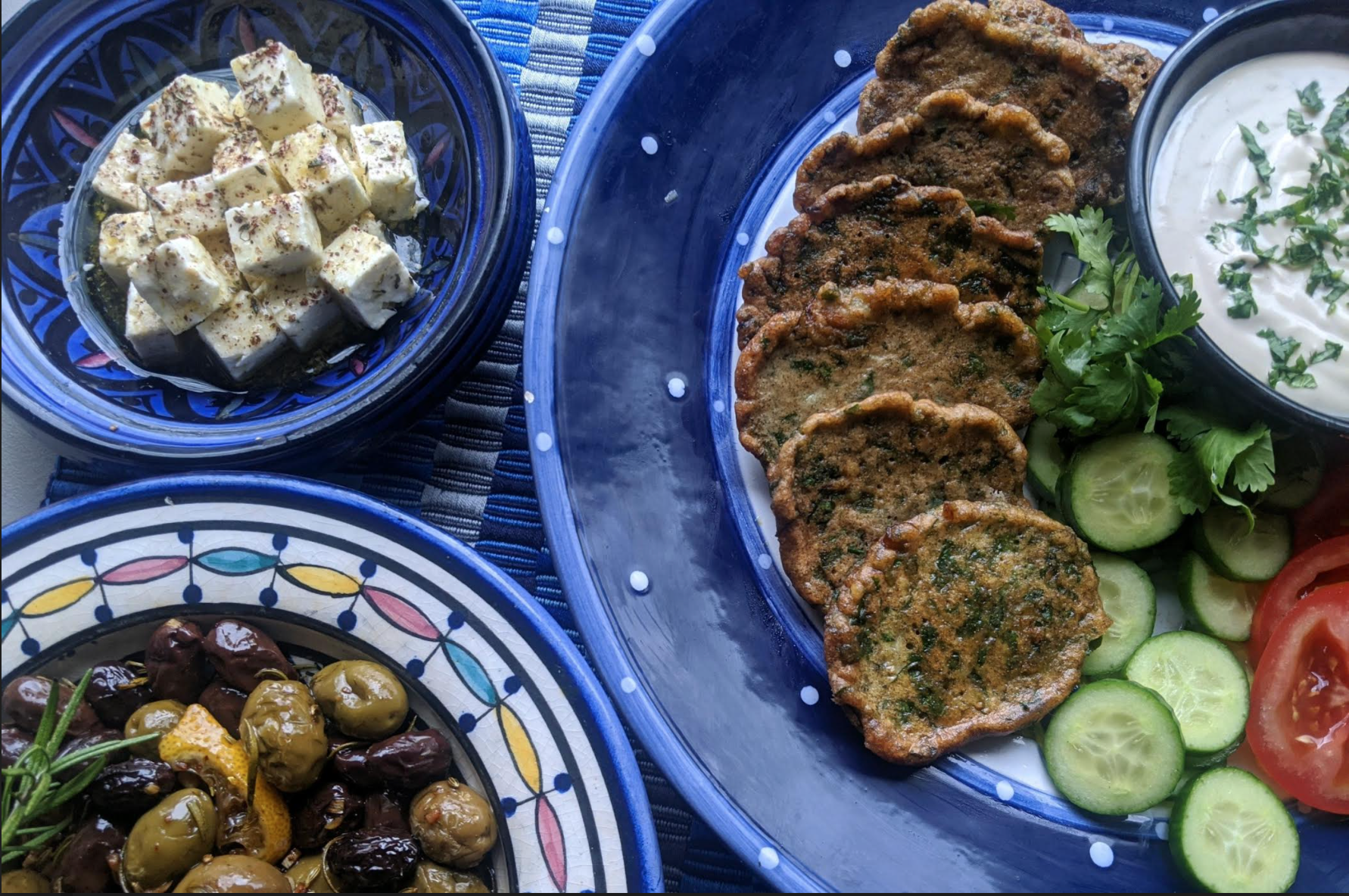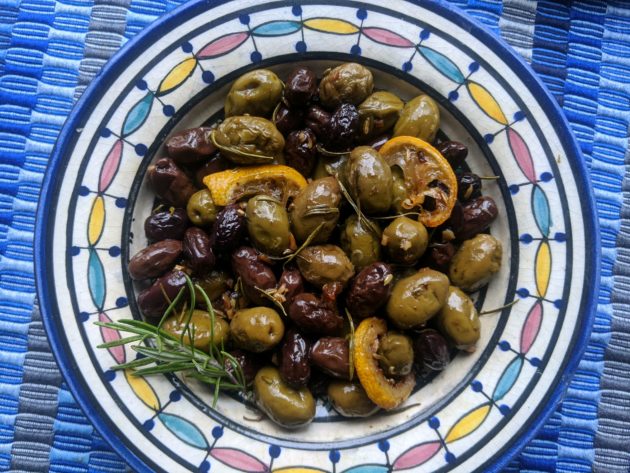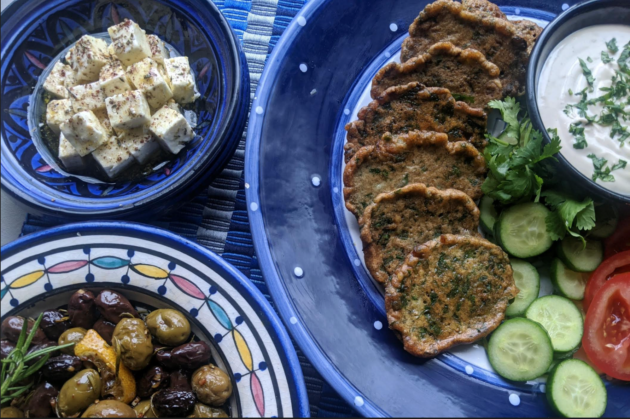
Embracing a Different Hanukkah
By Susan Barocas
Just for the record, I like latkes. Really, I do. But Hanukkah is eight days, people. That’s eight dinners, not to mention breakfasts and lunches. Sometimes I think it’s another Hanukkah miracle that we can still fit into our pants after even a night or two of latkes! And with all of us staying home nearly all the time, we do not want to be sitting in stale latke air day after day.
This year, so much about our lives––including how we celebrate holidays––is different, which makes it a perfect time to move beyond potato latkes and embrace some new ideas for delicious Hanukkah eating.
To start with, I am a big believer that all kinds of food that use oil qualify as Hanukkah food, from roasted vegetables to your favorite salads with oil in the dressings. That means the mezze I wrote about in May make for good Hanukkah eating, too. Try the marinated feta from that post with roasted spiced olives (below) for munching during serious dreidel playing.
The feta speaks to the tradition of eating dairy during Hanukkah to honor beautiful and brave Judith, who saved Jewish lives from Assyrian invaders. Desired by the commanding general, she fed him lots of salty cheese the night before he was to attack her village. As a result, he drank too much and fell into a drunken sleep. Judith used his own sword to cut off his head, leading to the Assyrian retreat. Growing up, I never knew this story of Judith, a member of the Maccabea tribe, who should be spoken about along with all those men of Hanukkah.
When we think about other alternatives to latkes, ejjeh patties are full of protein and herbs (gluten-free, too, with chickpea flour). They need less time in oil to cook than potatoes, so soak up less of it. Traditionally served during Hanukkah in Syrian Jewish communities, ejjeh are so good that you find them year-round at street food stands throughout the Middle East, wrapped in flatbread or stuffed into a chunk of baguette or a pita with fresh cucumbers and tomatoes, pickles, pickled vegetables and lemony tahini sauce. I enjoy them as much for breakfast as for dinner! You can add a little shredded zucchini to make ejjeh kusa or partially-cooked potatoes that are grated for ejjeh batata
During Hanukkah, eating foods that use oil in various ways celebrates the miracle of the light created by the oil that lasted while the Israelites reclaimed and rededicated the desecrated Temple. Even though we won’t be gathering with family and friends this year for Hanukkah parties, we can still reclaim the deeper meaning and joy of the holiday.
Each night we light the chanukiah, we bring more and more light into the world on the darkest days of the year. Life being what it is right now, we need the special, remarkable light of Hanukkah more than ever. We can rededicate ourselves to the strength, endurance and survival symbolized by the light. We can create memorable celebrations in our homes, even if home means just one or two of us, by lighting lots of menorahs (make mini-muffins or cupcakes for edible menorahs) and staying safe while connecting virtually with those we love.
Here are the promised different Hanukkah dishes to match this year’s very different Hanukkah.
(All recipes by Susan Barocas.)

Roasted Spiced Olives
1/2 lemon
3 tablespoons olive oil
2 cloves garlic, minced (about 2 teaspoons)
1/4 teaspoon fennel seeds or cumin seeds
1/4 teaspoon Aleppo pepper or crushed red pepper (optional)
1/4 to 1/2 teaspoon salt, if needed
2-3 sprigs rosemary
3 cups olives, assorted colors and sizes, all with or without pits (about 1 pound)
Preheat oven to 400 degrees.
Wash the lemons very well, then dry it. Cut the lemon in half the long way Slice one of the halves into thin half-moons.
In a medium mixing bowl, stir together the olive oil, garlic, fennel or cumin seeds, pepper and salt, if using. Add the lemons, rosemary and olives and stir to coat everything evenly. Pour the mixture and all the dressing into a baking dish, preferably glass or ceramic, just large enough to hold the olive mixture in one layer. Roast the olives about 25 minutes, until bubbly and the olives start to wrinkle. Stir once halfway through cooking. When the rosemary is cool enough to handle, run your finger down the stems to remove the leaves and scatter over the olives, discarding the stems
Serve warm from the oven or at room temperature with a squeeze of lemon juice or sprinkle of salt, if desired. Cooked olives can be refrigerated up to two weeks. Bring to room temperature before serving or heat briefly in a 350-degree oven.

Ejjeh
(Edjeh, Edgeh)
Makes 8-12 patties
6-7 tablespoons scallions, green and white parts, from 5 or 6 scallions
4 tablespoons parsley
4 tablespoons mint, dill and/or cilantro
4 large eggs
1 teaspoon ground allspice
1 teaspoon salt
1/4 teaspoon ground black pepper
1/2 cup chickpea flour*
1/4-1/2 cup olive or good vegetable oil such as grapeseed, safflower or avocado
Options for serving—sliced cucumbers and tomatoes, pickles, pickled vegetables, romaine lettuce leaves; baguette, pita or flatbread
Clean and chop into small pieces the scallions, parsley and other herbs. (Like Persian Jewish food, the cuisine of Syria takes advantage of the abundance of herbs growing there.)
In a large bowl, beat the eggs until they start to get foamy. Add all the ingredients except the flour and olive oil, and combine well. Add the flour and mix until well blended.
Heat about 1/4 cup oil in a large skillet at medium temperature. The oil is ready when a drop of water or batter sizzles in it. For each ejjeh, drop a heaping tablespoon or more of batter into the hot oil, depending on the desired size, then gently even out with the back of the spoon. Fry on each side about 3 to 4 minutes until golden brown. Add more oil as needed. Drain on paper towels or brown paper, or on a rack placed over a baking sheet lined with paper towels or brown paper.
Serve warm or at room temperature, stuffed into chunks of baguette or a pita or wrapped in flatbread, or create a lettuce wrap. Add fresh cucumbers and tomatoes, pickles, pickled vegetables, and drizzle with lemony tahini sauce. The ejjeh can be frozen, separated by parchment or waxed paper and wrapped well. Reheat briefly in a dry pan with a lid or in a 350-degree oven.
*Chickpea flour can sometimes be hard to find, in which case substitute almond flour or all-purpose flour. Not traditional, but still good.
You can make your own flatbread for the ejjeh, as we did in an earlier class. Recipes here.
Lemony Tahini Sauce
It’s so quick and easy to make this sauce that I almost always have some in my fridge to drizzle on vegetables, use as salad dressing and, of course, ejjeh or felafel or even latkes. Leave it thicker with less water to make a sandwich spread or tahini dip for fresh veggies, pita.
1/2 cup tahini (sesame paste)
1 medium or large clove garlic, grated or pressed
1/4 cup fresh lemon juice
1/2 teaspoon salt
5-6 tablespoons cold water
Stir together all the ingredients except the water in a bowl. The mixture will become stiff. Starting with 4 tablespoons, add just enough cold water until the sauce is still thick, but smooth and pourable. If it feels too thin, add a little more tahini. The sauce will keep in the refrigerator up to a week. Stir and thin with a little cold water to reconstitute consistency if necessary.
MARINATED FETA
8 to 10 ounces feta
1 to 2 cloves garlic, sliced thin
1 to 2 tablespoons za’atar
1 tablespoon lemon zest
Olive oil to fill container
Pat the feta dry. With a sharp, straight-edged knife, cut feta into bite-sized cubes. Put a couple garlic pieces, some za’atar and zest in the bottom of a jar or glass container that can hold all the feta. Put about 1/3 to 1/2 of the feta pieces in the container, depending on how deep it is. Add more garlic and za’atar. Repeat once or twice more until As you go, add slices of garlic all around the feta and sprinkle za’atar and lemon zest, saving some for the top and down sides. Fill the container or jar with olive oil, covering all the feta with extra oil on top. Close and refrigerate for at least a day or two. Remove the jar from the fridge before serving so any solidified oil can liquify. Keeps for a few weeks in the refrigerator.
This same technique is a great way to marinate olives, too. As you use the feta or olives, add the oil marinade to salad dressings or drizzle over cooked vegetables, fish or pasta.
ZA’ATAR
(this appears also in the mezze blog post)
Every spice vendor in Israel and throughout the Middle East has their own particular za’atar mix that they become known for. You should do the same and make this mix totally to your taste. Find a blend you like and then use it on pita with olive oil, hummus, babaganoush, labneh, feta, fish, chicken, in salad dressings…you get the idea! I add only a little salt and no cumin or coriander to the mix, preferring to control those ingredients for each recipe using za’atar. This recipe is for the mix I usually––though not always––use.
1 tablespoon dried thyme
2 tablespoons dried marjoram
2 tablespoon dried oregano
2 tablespoons sumac
2 tablespoons sesame seeds, toasted if preferred
½ teaspoon salt
Optional:
1 tablespoon ground cumin
1 tablespoon ground coriander
½ teaspoon Aleppo pepper, more or less depending on the heat desired
Mix together well. Adjust for personal taste. Store in a jar or glass container tightly covered. When you use the za’atar, you can crumble it a bit by hand to release more flavor and aroma.
HAPPY HANUKKAH!



